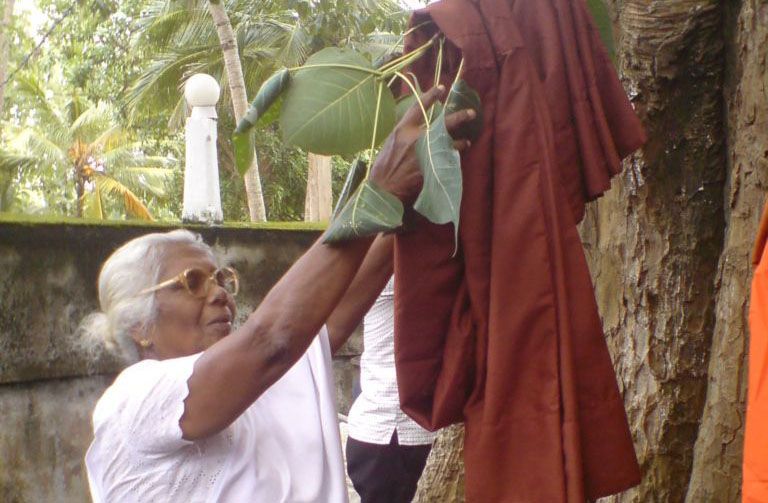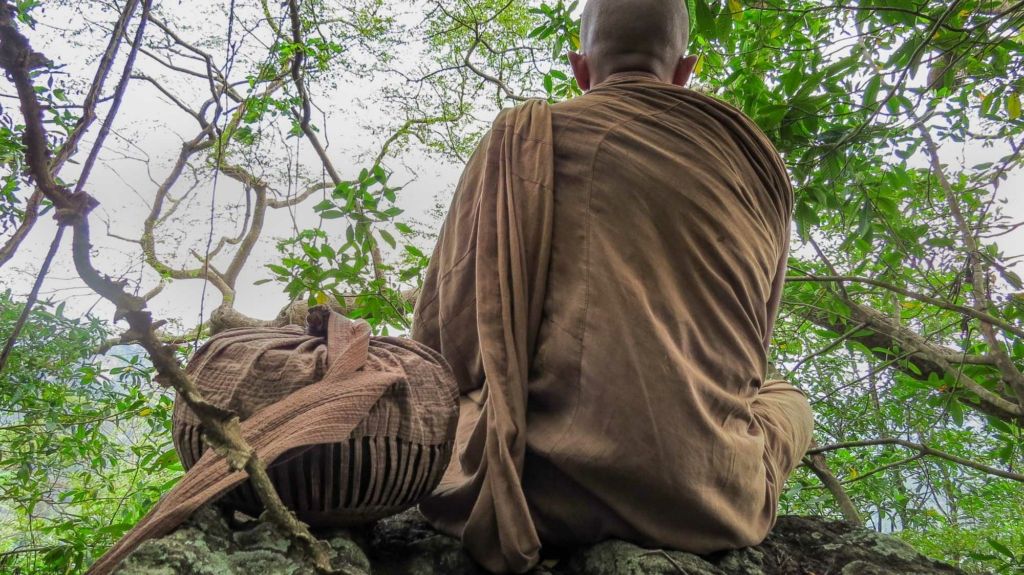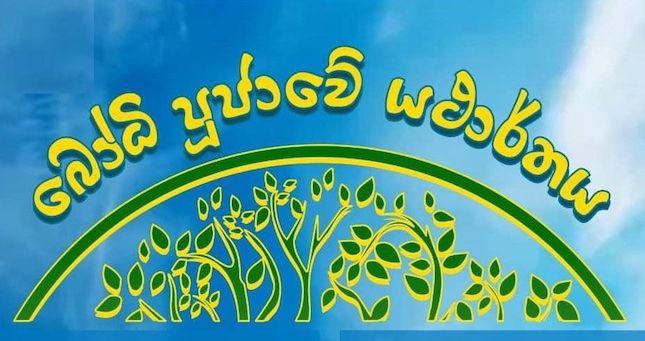
Bodhi-Puja
The veneration of the Bodhi-tree (pipal tree: ficus religiosa) has been a popular and a widespread ritual in Sri Lanka from the time a sapling of the original Bodhi-tree at Buddhagaya (under which the Buddha attained Enlightenment) was brought from India by the Theri Sanghamitta and planted at Anuradhapura during the reign of King Devanampiya Tissa in the third century B.C. Since then a Bodhi-tree has become a necessary feature of every Buddhist temple in the island.
The ritualistic worship of trees as abodes of tree deities (rukkha-devata) was widely prevalent in ancient India even before the advent of Buddhism. This is exemplified by the well-known case of Sujata’s offering of milk-rice to the Bodhisatta, who was seated under a banyan tree on the eve of his Enlightenment, in the belief that he was the deity living in that tree. By making offerings to these deities inhabiting trees the devotees expect various forms of help from them. The practice was prevalent in pre-Buddhist Sri Lanka as well.
According to the Mahavamsa, King Pandukabhaya (4th century B.C.) fixed a banyan tree near the western gate of Anuradhapura as the abode of Vessavana, the god of wealth and the regent of the North as well as the king of the yakkhas. The same king set apart a palmyra palm as the abode of vyadha-deva, the god of the hunt (Mhv. x,89, 90).
After the introduction of the Bodhi-tree, this cult took a new turn. While the old practice was not totally abandoned, pride of place was accorded to the worship of the pipal tree, which had become sacred to the Buddhists as the tree under which Gotama Buddha attained Enlightenment. Thus there is a difference between the worship of the Bodhi-tree and that of other trees.
To the Buddhists, the Bodhi-tree became a sacred object belonging to the paribhogika group of the threefold division of sacred monuments, while the ordinary veneration of trees, which also exists side-by-side with the former in Sri Lanka, is based on the belief already mentioned, i.e. that there are spirits inhabiting these trees and that they can help people in exchange for offerings.
The Buddhists also have come to believe that powerful Buddhist deities inhabit even the Bodhi-trees that receive worship in the purely Buddhist sense. Hence it becomes clear that the reverence shown to a tree is not addressed to the tree itself. However, it also has to be noted that the Bodhi-tree received veneration in India even before it assumed this Buddhist significance; this practice must have been based on the general principle of tree worship mentioned above.
Once the tree assumed Buddhist significance its sanctity became particularized, while the deities inhabiting it also became associated with Buddhism in some form. At the same time, the tree became a symbol representing the Buddha as well. This symbolism was confirmed by the Buddha himself when he recommended the planting of the Ananda Bodhi-tree at Jetavana for worship and offerings during his absence (see J.iv,228f.). Further, the place where the Buddha attained Enlightenment is mentioned by the Buddha as one of the four places of pilgrimage that should cause serene joy in the minds of the faithful (D.ii,140). As Ananda Coomaraswamy points out, every Buddhist temple and monastery in India once had its Bodhi-tree and flower altar as is now the case in Sri Lanka.
King Devanampiya Tissa, the first Buddhist king of Sri Lanka, is said to have bestowed the whole country upon the Bodhi-tree and held a magnificent festival after planting it with great ceremony. The entire country was decorated for the occasion. The Mahavamsa refers to similar ceremonies held by his successors as well. It is said that the rulers of Sri Lanka performed ceremonies in the tree’s honour in every twelfth year of their reign (Mhv. xxxviii,57).
King Dutugemunu (2nd century B.C.) performed such a ceremony at a cost of 100,000 pieces of money (Mhv. xxviii,1). King Bhatika Abhaya (1st century A.C.) held a ceremony of watering the sacred tree, which seems to have been one of many such special pujas. Other kings too, according to the Mahavamsa, expressed their devotion to the Bodhi-tree in various ways (see e.g. Mhv. xxxv,30; xxxvi, 25, 52, 126).
It is recorded that forty Bodhi-saplings that grew from the seeds of the original Bodhi-tree at Anuradhapura were planted at various places in the island during the time of Devanampiya Tissa himself. The local Buddhists saw to it that every monastery in the island had its own Bodhi-tree, and today the tree has become a familiar sight, all derived, most probably, from the original tree at Anuradhapura through seeds. However, it may be added here that the notion that all the Bodhi-trees in the island are derived from the original tree is only an assumption. The existence of the tree prior to its introduction by the Theri Sanghamitta cannot be proved or disproved.
The ceremony of worshipping this sacred tree, first begun by King Devanampiya Tissa and followed by his successors with unflagging interest, has continued up to the present day. The ceremony is still as popular and meaningful as at the beginning. It is natural that this should be so, for the veneration of the tree fulfils the emotional and devotional needs of the pious heart in the same way as does the veneration of the Buddha-image and, to a lesser extent, of the dagaba.Moreover, its association with deities dedicated to the cause of Buddhism, who can also aid pious worshippers in their mundane affairs, contributes to the popularity and vitality of Bodhi-worship.
The main centre of devotion in Sri Lanka today is, of course, the ancient tree at Anuradhapura, which, in addition to its religious significance, has an historical importance as well. As the oldest historical tree in the world, it has survived for over 2,200 years, even when the city of Anuradhapura was devastated by foreign enemies. Today it is one of the most sacred and popular places of pilgrimage in the island. The tree itself is very well guarded, the most recent protection being a gold-plated railing around the base (ranvata).
Ordinarily, pilgrims are not allowed to go near the foot of the tree in the upper terrace. They have to worship and make their offerings on altars provided on the lower terrace so that no damage is done to the tree by the multitude that throng there. The place is closely guarded by those entrusted with its upkeep and protection, while the daily rituals of cleaning the place, watering the tree, making offerings, etc., are performed by bhikkhus and laymen entrusted with the work. The performance of these rituals is regarded as of great merit and they are performed on a lesser scale at other important Bodhi-trees in the island as well.
Thus this tree today receives worship and respect as a symbol of the Buddha himself, a tradition which, as stated earlier, could be traced back to the Ananda Bodhi-tree at Jetavana of the Buddha’s own time. The Vibhanga Commentary (p.349) says that the bhikkhu who enters the courtyard of the Bodhi-tree should venerate the tree, behaving with all humility as if he were in the presence of the Buddha. Thus one of the main items of the daily ritual at the Anuradhapura Bodhi-tree (and at many other places) is the offering of alms as if unto the Buddha himself. A special ritual held annually at the shrine of the Anuradhapura tree is the hanging of gold ornaments on the tree. Pious devotees offer valuables, money, and various other articles during the performance of this ritual.
Another popular ritual connected with the Bodhi-tree is the lighting of coconut-oil lamps as an offering (pahan-puja), especially to avert the evil influence of inauspicious planetary conjunctions. When a person passes through a troublesome period in life he may get his horoscope read by an astrologer in order to discover whether he is under bad planetary influences. If so, one of the recommendations would invariably be a bodhi-puja,one important item of which would be the lighting of a specific number of coconut-oil lamps around a Bodhi-tree in a temple. The other aspects of this ritual consist of the offering of flowers, milk-rice, fruits, betel, medicinal oils, camphor, and coins. These coins (designated panduru) are washed in saffron water and separated for offering in this manner.
The offering of coins as an act of merit-acquisition has assumed ritualistic significance with the Buddhists of the island. Every temple has a charity box (pin-pettiya) into which the devotees drop a few coins as a contribution for the maintenance of the monks and the monastery. Offerings at devalayas should inevitably be accompanied by such a gift. At many wayside shrines there is provision for the offering of panduru and travellers en route, in the hope of a safe and successful journey, rarely fail to make their contribution. While the coins are put into the charity box, all the other offerings would be arranged methodically on an altar near the tree and the appropriate stanzas that make the offering valid are recited. Another part of the ritual is the hanging of flags on the branches of the tree in the expectation of getting one’s wishes fulfilled.
Bathing the tree with scented water is also a necessary part of the ritual. So is the burning of incense, camphor, etc. Once all these offerings have been completed, the performers would circumambulate the tree once or thrice reciting an appropriate stanza. The commonest of such stanzas is as follows:
Yassa mule nisinno va
sabbari vijayam aka
patto sabbannutam Sattha
Vande tam bodhipadapam.
Ime ete mahabodhi
lokanathena pujita
ahampi te namassami
bodhi raja namatthu te.
“I worship this Bodhi-tree seated under which the Teacher attained omniscience by overcoming all enemical forces (both subjective and objective). I too worship this great Bodhi-tree which was honoured by the Leader of the World. My homage to thee, O King Bodhi.”
The ritual is concluded by the usual transference of merit to the deities that protect the Buddha’s Dispensation.
from “Buddhist Ceremonies and Rituals of Sri Lanka”
by A.G.S. Kariyawasam
The Wheel Publication No. 402/404








